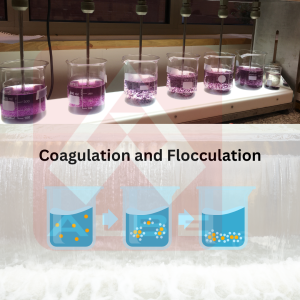Have you heard about how bioaugmentation wastewater treatment is revolutionizing the industry? If you caught our previous article here on the subject, you already know that advanced biological methods are changing the game. But before these microorganisms can work their magic, the water needs to be pre-conditioned. That’s where coagulation and flocculation in water treatment come in—two critical steps that ensure your wastewater treatment runs smoothly.

WHAT ARE COAGULATION AND FLOCCULATION?
Imagine you’re at a party, and everyone is scattered around in small, disconnected groups. Coagulation and flocculation in water treatment are like the party planners who get people mingling together. These processes are especially important in an industrial wastewater treatment system, where they help to efficiently separate and remove contaminants before further treatment.
Here’s how they work:
Coagulation
Chemicals are added to the water, acting like social facilitators. They neutralize the charges of tiny particles and impurities, causing them to clump together.
Flocculation
Once the particles start sticking together, flocculation takes over. This step involves gently stirring or mixing the water to help the smaller clumps or “flocs” merge into even larger clusters and ready for removal.
WHY ARE COAGULATION AND FLOCCULATION SO IMPORTANT?
- Clearing the Water: Coagulation and flocculation remove suspended solids and impurities, making the water easier to treat. It’s like decluttering your workspace before starting a project—everything flows more smoothly when you start with a clean slate.
- Boosting Efficiency: With fewer particles in the way, subsequent wastewater treatment technology processes can operate more efficiently. Think of it as clearing the path for the specialized microorganisms to do their job without distractions.
- Preventing Overload: A treatment system overloaded with particles can malfunction. Coagulation and flocculation reduce the load on the system, preventing potential issues down the line.
- Meeting Standards: Treatment plants need to comply with strict environmental regulations. By improving water quality early in the process, coagulation and flocculation help ensure that the treated water meets regulatory standards.
- Cost-Effective: With fewer impurities to deal with, there’s less need for expensive chemicals and less energy required. This makes the overall process more economical and environmentally friendly.
How Do Coagulation and Flocculation Enhance Bioaugmentation?
In the bioaugmentation wastewater treatment process, specialized microorganisms break down pollutants more efficiently. Coagulation and flocculation in water treatment are crucial pre-treatment steps that set the stage for bioaugmentation to work its magic. Here’s how:
By removing suspended solids, these pre-treatment steps create a more favorable environment for the microorganisms to do their work.
With fewer particles obstructing their path, microorganisms can more effectively target and break down organic pollutants.
Less clutter in the water means that bioaugmentation systems can operate more effectively, reducing the risk of system overload and enhancing overall performance.
As you can see, coagulation and flocculation are the unsung heroes of wastewater treatment technology. They set the stage for bioaugmentation wastewater treatment, ensuring that the entire process is efficient, cost-effective, and compliant with regulations. Additionally, integrating a membrane bioreactor for wastewater treatment can further enhance the effectiveness of your system by providing advanced filtration and biological treatment. Ready to transform your wastewater treatment and save on costs and manpower? Get in touch with us today to schedule your free consultation. Let’s revolutionize your water treatment processes together!

